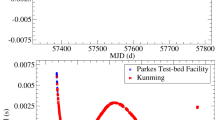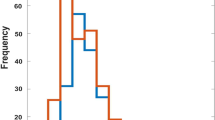Abstract
We present a timing analysis of PSR J1602–5100 using approximately seven years of observations from the Parkes 64-m radio telescope. A slow glitch that occurred between 2008 September 24 and 2010 May 14 (MJDs 54733 and 55330) is identified. During this time, the pulsar showed a slow exponential growth in the spin frequency \(\nu\), and the spin-down rate \(|\dot{\nu}|\) suddenly decreased to a peak value, followed by a linear return to its initial value. Our measurements of the maximum \(\Delta \nu\) and \(\Delta\dot{\nu}\) are \(176~\mbox{nHz}\) and \(3.58\times 10^{-15}~\text{s}^{-2}\), corresponding to fractional sizes of \(152\times10^{-9}\) \((\Delta\nu/\nu)\) and \(-38.6\times10^{-3}\) \((\Delta\dot{\nu}/\dot {\nu})\), respectively. This is the largest slow glitch observed so far. Moreover, more complex changes in the shape of the pulse profile are considered to be associated with this unusual glitch activity.
Similar content being viewed by others
Avoid common mistakes on your manuscript.
1 Introduction
Pulsar glitches are among the universe’s most bizarre phenomena, which have been studied extensively due to their potential applications in understanding the neutron-star interior and magnetosphere. Signifying an increase in frequency \(\nu\), pulsar glitches are viewed as a rarity. Until now, only 547 spin jump events have been reported in 188 pulsars (for a more complete list of glitches, see the Jodrell Bank Glitch CatalogueFootnote 1) (Espinoza et al. 2011). Most of these pulsars, in general, exhibit normal glitch behaviours, in which frequencies abruptly increase in a very short time (on the order of minutes) (Vivekanand 2017). However, it has been observed that the increased pulse frequencies of a few pulsars build up in another unusual way known as a slow glitch (Xie and Zhang 2013).
The slow glitch was first coined when Zou et al. (2004) tracked the evolution of the frequency \(\nu\) and first-order frequency derivative \(\dot{\nu}\) of PSR B1822–09, with a continuous increase in \(\nu\) over several hundreds of days. This process corresponds to an impulsive decrease in the spin-down rate \(|\dot{\nu}|\) followed by an exponential increase to its pre-glitch value. Next, a similar phenomenon was observed in the pulsars PSRs B1642–03 (Shabanova 2009a) and B0919+06 (Shabanova 2010). Yuan et al. (2010) found two new slow glitching pulsars, PSRs J0631+1036 and B1907+10. Yu et al. (2013) showed the slow-glitch features occurring in PSR J1539–5626. Since 2004, a total of 30 slow glitches have been detected. The maximum change range of the rotational frequency \(\nu\) and the first time-derivative of the frequency \(\dot {\nu}\) are \(2.3\mbox{--}46~\mbox{nHz}\) and \(0.15 \times10^{-15}\mbox{--}3.15 \times10^{-15}~\mbox{s}^{-2}\), corresponding to a maximum fractional change \(\Delta\nu/\nu\sim 0.9 \times10^{-9} \mbox{--} 31.2 \times10^{-9}\) and \(|\Delta\dot{\nu}/\dot{\nu}|\sim1.8\times10^{-3}\mbox{--}23.6\times10^{-3}\), respectively.
For a normal glitch, the angular momentum exchange model (Anderson and Itoh 1975; Alpar et al. 1981) is now widely accepted. At this point, neutron stars are considered to consist of two components. One is the solid crust, which spins down due to the effect of the electromagnetic braking torque, and the other is the interior superfluid, which can be regarded as a container of angular momentum (Eya et al. 2017). In some cases, angular momentum is transferred from the superfluid to the crust, ultimately leading to a spin-up of what we have seen in glitching pulsars (Andersson et al. 2012; Pizzochero et al. 2017). However, this model cannot be used to explain the process that causes slow glitches. Link and Epstein (1996) suggested that slow glitches occur as a result of a sudden increase in temperature in the inner crust. Hobbs et al. (2010) suggested that the slow glitch cannot be labelled as a category of pulsar glitches. Because it is a manifestation of timing noise, their rotational rates wander with time scales of days, months and years (Cordes and Helfand 1980).
The cause of slow glitches has remained a mystery. Therefore, there is a great significance in increasing the number of samples of known slow spin-up events. PSR J1602–5100 (B1558–50) was discovered with the Parkes 64-m radio telescope in 1973 (Komesaroff et al. 1973). The pulsar has a relatively large rotation period, 864.2 ms, and the measured time derivative of the period (\(\dot{P}=69.580\times10^{-15}\)) gives a surface magnetic flux density \(B_{s}=3.2\times10^{19} \sqrt{P\dot{P}}\), of \(7.85\times 10^{12}~\mbox{G}\) and a spin down energy loss rate \(|\dot{E}|=4\pi^{2}I\dot{P}P^{-3}\), of \(4.3\times10^{33}~\mbox{erg}\,\mbox{s}^{-1}\). Based on the YMW16 electron density model (Yao et al. 2017), the earth-pulsar distance is estimated to be \(8~\mbox{kpc}\). Since 1973, a glitch history has never been reported for this 197 kyr (characteristic age \(\tau_{c}=P/2\dot{P}\)) pulsar.
In this paper, we present the largest slow glitch detected in PSR J1602–5100 with timing observations from the Parkes 64-m radio telescope between 2007 and 2015. In Sect. 2, we describe the observations, and our method for determining the glitch parameters. Section 3 shows our results, which focus on the glitch behaviours. Some discussions of our results are presented in Sect. 4, and finally, we end the paper with a summary in the last section.
2 Observations and analysis
Timing observations at the Parkes radio telescope have been described in detail by Manchester et al. (2013). Here, we obtained 84 observations for PSR J1602–5100 between 2007 and 2015, which are public for download from the Parkes pulsar data archiveFootnote 2 (Hobbs et al. 2011). In brief, all these observations used the centre beam of the 20-cm multi-beam receiver with a central frequency of 1369 MHz and a bandwidth of 256 MHz. Observing sessions have typical intervals of 2–4 weeks. A suite of digital filter-bank systems was employed to acquire the data, with a sub-integration time of 30 s and integration times of 3–6 min.
The psrchive pulsar data analysis package (Hotan et al. 2004) was applied to the off-line data reduction. A total intensity pulse profile was formed by summing each observation in terms of frequency, time and polarization. Topocentric times of arrival (ToAs) were obtained through cross-correlation between a high signal-to-noise ratio (S/N) standard profile and each of the total intensity profiles. With the Jet Propulsion Laboratory’s (JPL) planetary ephemeris DE405 (Standish 1998), the times of arrival were transformed to a Solar System barycentre. The pulsar timing software package tempo2 (Hobbs et al. 2006) was used to fit the barycentred times of arrival with a model, weighted by the inverse square of their uncertainty. This model contains a set of parameters for a rotational pulsar phase and can be defined by a Taylor expansion (Edwards et al. 2006):
where \(\nu\), \(\dot{\nu}\) and \(\ddot{\nu}\) represent the pulse frequency, its first-level derivative and its second-level derivative, respectively.
In Table 1, the parameters for PSR J1602–5100, which can be used to predict the pulse arrival times with the pulsar’s rotational model, are listed. The specific parameters include the pulsar’s coordinates of J2000 (right ascension RA, declination DEC), the spin period (\(P\)), the spin-down rate (\(\dot{P}\)), the dispersion measure (DM), and the epoch of parameter determination. Timing residuals are analysed using the observed pulse times-of-arrival to compare with the predicted arrival times (Edwards et al. 2006). Employing a linear least-squares fit, we perform timing residuals analysis to achieve phase coherency and minimize the root-mean-square (RMS) values. Hence, the variations in the rotation rate can be investigated. This involves detecting not just normal glitches but also slow glitches and other irregularities. Additionally, the frequency \(\nu\) and first-order frequency derivative \(\dot{\nu}\) at any time can be derived from extrapolation of the timing solutions, and thus, we are able to calculate the relative amplitudes of the changes.
3 Result
With approximately 7 yrs of data at Parkes, we release the timing behaviours of PSR J1602–5100. This pulsar has a large second-order time derivative of the pulse frequency, which is an indicator of strong timing noise. This means that it is difficult to make the timing residuals phase connected. To address this issue, exact pulse numbers for each observation are obtained with a higher-order polynomial subtracted in the process of the least-squares fit. After \(\nu\) and \(\dot{\nu}\) are fitted, the timing residuals are as displayed in Fig. 1, with panel (a) representing relative to the model before MJD 54691 and panel (b) representing the result after fitting for \(\nu \) and \(\dot{\nu}\) over the whole data set. Panel (a) shows that the timing residuals run continuously from the beginning to MJD 54691 and thereafter gradually decrease. The evolution of the residuals in the two plots are remarkably similar to those of the third slow glitch detected in PSR B1822–09 (shown in Fig. 1 of Zou et al. 2004). These findings suggest that there is a possible slow glitch around MJD 54691.
Timing residuals for PSR J1062–5100: (a) with respect to the pre-glitch spin-down solution and (b) derived from fitting to \(\nu\) and \(\dot {\nu}\) for the whole data set. The two red dashed vertical lines split our data into three sections: pre-glitch (MJD 54303–54691), slow glitch (54733–55330), and post-glitch (55363–56741)
To determine if slow spin growth actually occurs, we apply the spin-down model to separately fit to a series of data with overlapping observations (spanning 50–150 d), obtaining the individual values of \(\nu\) and \(\dot{\nu}\) at the various times. Full timing solutions are presented in Table 2. Figure 2 demonstrates the evolution of \(\nu\) and \(\dot{\nu}\) over time at different ages. Obviously, there is a very clear large slow glitch in PSR J1602–5100. During the slow glitch, this pulsar exhibits a slow exponential growth in the rotational frequency and a sharp decrease to the minimum in the spin-down rate, followed by a linear increase to its original value, both of which are completed over approximately 600 d across MJD 54733. The maximum change \(\Delta\nu _{\max}\) is \(176~\mbox{nHz}\), which is derived from the difference between the extrapolation frequencies at MJD 55363. Similarly, the peak value of \(\Delta\dot{\nu}_{\max}\) is \(3.58\times10^{-15}~\mbox{s}^{-2}\) at MJD 54881. As a result, the maximum fractional changes in the frequency and frequency derivative are \(\Delta\nu/\nu=152(1)\times10^{-9}\) and \(\Delta\dot{\nu}/\dot{\nu}=-38.6(4)\times10^{-3}\), respectively. Similar to other slow glitches, \(\nu\) and \(\dot{\nu}\) remain unchanged after the slow glitch.
The first slow glitch in PSR J1062–5100: (a) Variations of the frequency residual \(\Delta\nu\) after subtracting the pre-glitch spin-down model. (b) Observed variations of \(\dot{\nu}\). Two red dashed vertical lines indicate that the slow glitch occurred between MJD 54733 and 55330. The \(\nu\) and \(\dot{\nu}\) reach their peak points of change at MJD 55363 and MJD 54881, respectively
4 Discussion
The first spin-up event in PSR J1602–5100 was discovered in our work, and an unusual glitch behaviour was observed at that time. This new slow glitch is rather similar but not identical to the other published slow glitches of six pulsars. For comparison, the observed glitch parameters of all slow glitches are gathered in Table 3. Undoubtedly, the slow glitch of PSR J1602–5100 exhibits the largest magnitude change in both the spin frequency and its first-level derivative. For known slow glitching pulsars, PSR B1822–09 is the one given the most attention. This pulsar is one repeating source, suffering a series of five slow spin-up events approximately once every two years. Furthermore, the occurrence of normal glitches for PSR B1822–09 is of special interest (Shabanova 2009b). PSR J1602–5100 is similar to PSR B1822–09. The parameters for the two pulsars are comparable in terms of the period \(P\), first derivative of the period \(\dot{P}\), characteristic age \(\tau_{c}\) and surface dipole magnetic field \(B_{s}\). However, no normal glitch has been observed in PSR J1602–5100. Furthermore, the process of \(\dot{\nu}\) decay back to the initial value in PSR J1602–5100 is linear rather than exponential, as in PSR B1822–09. The relative magnitude (\(\Delta\nu/\nu\sim152\times10^{-9}\)) in PSR J1602–5100 is three times larger than the cumulative fractional glitch size (\(\Delta\nu/\nu\sim55\times10^{-9}\)) of all five slow glitches in PSR B1822–09.
Prior to our work, Brook et al. (2016) found that a new profile component appeared between MJD \(\sim54700\) and MJD \(\sim55300\) in PSR J1602–5100. The time scale corresponds to the beginning and end of this slow glitch. Therefore, we conclude that this slow glitch is linked to changes in the shape of the pulse profile. The pulse profile change has also been observed in several pulsars after triggering of a normal glitch, including PSR J1119–6127 (Weltevrede et al. 2011), PSR J0742–2822 (Keith et al. 2013), PSR J2021+4026 (Zhao et al. 2017) and PSR B2035+36 (Kou et al. 2018). Unlike PSR J1602–5100, these pulsars show a switch only between narrow and wide pulse widths. This suggests that slow glitches have a possible different origin from that of normal glitches.
Based on the suggestion that a slow glitch is a kind of signature of timing noise, a large number of slow glitches are expected. However, to date, only a handful have been found. These facts cause us to believe that the slow glitch is indeed a new type of pulsar spin irregularity. Peng et al. (2018) proposed that the oscillation between two phases of an anisotropic superfluid is the mechanism behind the slow glitch. This model can be used to explain why a slow glitch is discovered only in relatively older pulsars and to estimate the time scale of a slow glitch. This estimation gives a duration \(\Delta t\) of between \(10^{4}\) and \(10^{6}~\text{s}\), which is much less than that observed. Thus, this model should be improved.
5 Summary
In this paper, an unusual glitch is detected in PSR J1602–5100 at Parkes Observatory, which is the largest slow glitch, is presented in detail. Most importantly, this slow glitch correlates with its pulse profile change, which is different from the two mode changes following normal glitches. Apparently, the slow glitch is a new class of period glitch. There is no doubt that it opens a new avenue of investigation that could ultimately lead to an improved understanding of neutron-star interiors and the magnetosphere. However, too little progress has been made. Hence, persistence in carrying out pulsar timing observations should occur.
References
Alpar, M.A., Anderson, P.W., Pines, D., Shaham, J.: Astrophys. J. Lett. 249, 29 (1981)
Anderson, P.W., Itoh, N.: Nature 256, 25 (1975)
Andersson, N., Glampedakis, K., Ho, W.C.G., Espinoza, C.M.: Phys. Rev. Lett. 109(24), 241103 (2012)
Brook, P.R., Karastergiou, A., Johnston, S., Kerr, M., Shannon, R.M., Roberts, S.J.: Mon. Not. R. Astron. Soc. 456, 1374 (2016)
Cordes, J.M., Helfand, D.J.: Astrophys. J. 239, 640 (1980)
D’Alessandro, F., McCulloch, P.M., King, E.A., Hamilton, P.A., McConnell, D.: Mon. Not. R. Astron. Soc. 261, 883 (1993)
Edwards, R.T., Hobbs, G.B., Manchester, R.N.: Mon. Not. R. Astron. Soc. 372, 1549 (2006)
Espinoza, C.M., Lyne, A.G., Stappers, B.W., Kramer, M.: Mon. Not. R. Astron. Soc. 414, 1679 (2011)
Eya, I.O., Urama, J.O., Chukwude, A.E.: Astrophys. J. 840, 56 (2017)
Hobbs, G.B., Edwards, R.T., Manchester, R.N.: Mon. Not. R. Astron. Soc. 369, 655 (2006)
Hobbs, G., Lyne, A.G., Kramer, M.: Mon. Not. R. Astron. Soc. 402, 1027 (2010)
Hobbs, G., Miller, D., Manchester, R.N., Dempsey, J., Chapman, J.M., Khoo, J., Applegate, J., Bailes, M., Bhat, N.D.R., Bridle, R., Borg, A., Brown, A., Burnett, C., Camilo, F., Cattalini, C., Chaudhary, A., Chen, R., D’Amico, N., Kedziora-Chudczer, L., Cornwell, T., George, R., Hampson, G., Hepburn, M., Jameson, A., Keith, M., Kelly, T., Kosmynin, A., Lenc, E., Lorimer, D., Love, C., Lyne, A., McIntyre, V., Morrissey, J., Pienaar, M., Reynolds, J., Ryder, G., Sarkissian, J., Stevenson, A., Treloar, A., van Straten, W., Whiting, M., Wilson, G.: Proc. Astron. Soc. Aust. 28, 202 (2011)
Hotan, A.W., van Straten, W., Manchester, R.N.: Proc. Astron. Soc. Aust. 21, 302 (2004)
Keith, M.J., Shannon, R.M., Johnston, S.: Mon. Not. R. Astron. Soc. 432, 3080 (2013)
Komesaroff, M.M., Ables, J.G., Cooke, D.J., Hamilton, P.A., McCulloch, P.M.: Astrophys. Lett. 15, 169 (1973)
Kou, F.F., Yuan, J.P., Wang, N., Yan, W.M., Dang, S.J.: Mon. Not. R. Astron. Soc. 478, 24 (2018)
Link, B., Epstein, R.I.: Astrophys. J. 457, 844 (1996)
Manchester, R.N., Hobbs, G., Bailes, M., Coles, W.A., van Straten, W., Keith, M.J., Shannon, R.M., Bhat, N.D.R., Brown, A., Burke-Spolaor, S.G., Champion, D.J., Chaudhary, A., Edwards, R.T., Hampson, G., Hotan, A.W., Jameson, A., Jenet, F.A., Kesteven, M.J., Khoo, J., Kocz, J., Maciesiak, K., Oslowski, S., Ravi, V., Reynolds, J.R., Sarkissian, J.M., Verbiest, J.P.W., Wen, Z.L., Wilson, W.E., Yardley, D., Yan, W.M., You, X.P.: Proc. Astron. Soc. Aust. 30, 017 (2013)
Peng, Q.H., Liu, J.J., Chou, C.K.: arxiv:1810.01743 (2018)
Pizzochero, P.M., Antonelli, M., Haskell, B., Seveso, S.: Nat. Astron. 1, 0134 (2017)
Shabanova, T.V.: Astron. Astrophys. 337, 723 (1998)
Shabanova, T.V.: Mon. Not. R. Astron. Soc. 356, 1435 (2005)
Shabanova, T.V.: Astrophys. J. 700, 1009 (2009a)
Shabanova, T.V.: Astron. Rep. 53, 465 (2009b)
Shabanova, T.V.: Astrophys. J. 721, 251 (2010)
Shabanova, T.V., Urama, J.O.: Astron. Astrophys. 354, 960 (2000)
Standish, E.M.: Astron. Astrophys. 336, 381 (1998)
Vivekanand, M.: Astron. Astrophys. 597, 9 (2017)
Weltevrede, P., Johnston, S., Espinoza, C.M.: Mon. Not. R. Astron. Soc. 411, 1917 (2011)
Xie, Y., Zhang, S.-N.: Astrophys. J. 778, 31 (2013)
Yao, J.M., Manchester, R.N., Wang, N.: Astrophys. J. 835, 29 (2017)
Yu, M., Manchester, R.N., Hobbs, G., Johnston, S., Kaspi, V.M., Keith, M., Lyne, A.G., Qiao, G.J., Ravi, V., Sarkissian, J.M., Shannon, R., Xu, R.X.: Mon. Not. R. Astron. Soc. 429, 688 (2013)
Yuan, J.P., Wang, N., Manchester, R.N., Liu, Z.Y.: Mon. Not. R. Astron. Soc. 404, 289 (2010)
Zhao, J., Ng, C.W., Lin, L.C.C., Takata, J., Cai, Y., Hu, C.-P., Yen, D.C.C., Tam, P.H.T., Hui, C.Y., Kong, A.K.H., Cheng, K.S.: Astrophys. J. 842, 53 (2017)
Zou, W.Z., Wang, N., Wang, H.X., Manchester, R.N., Wu, X.J., Zhang, J.: Mon. Not. R. Astron. Soc. 354, 811 (2004)
Acknowledgements
The Parkes radio telescope is part of the Australia Telescope, which is funded by the Commonwealth of Australia for operation as a National Facility managed by the Commonwealth Scientific and Industrial Research Organisation (CSIRO). Our work is supported by National Natural Science Foundation of China (Nos. 11305133, 11273020 and 11847048). We would like to express our gratitude to everyone who contributed to make this study possible.
Author information
Authors and Affiliations
Corresponding author
Additional information
Publisher’s Note
Springer Nature remains neutral with regard to jurisdictional claims in published maps and institutional affiliations.
Rights and permissions
About this article
Cite this article
Zhou, S.Q., Zhou, A.A., Zhang, J. et al. A very large slow glitch in PSR J1602–5100. Astrophys Space Sci 364, 173 (2019). https://doi.org/10.1007/s10509-019-3660-7
Received:
Accepted:
Published:
DOI: https://doi.org/10.1007/s10509-019-3660-7






